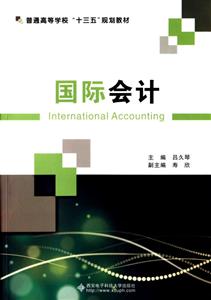-
>
中医基础理论
-
>
高校军事课教程
-
>
思想道德与法治(2021年版)
-
>
毛泽东思想和中国特色社会主义理论体系概论(2021年版)
-
>
中医内科学·全国中医药行业高等教育“十四五”规划教材
-
>
中医诊断学--新世纪第五版
-
>
中药学·全国中医药行业高等教育“十四五”规划教材
国际会计::: 版权信息
- ISBN:9787560639178
- 条形码:9787560639178 ; 978-7-5606-3917-8
- 装帧:一般胶版纸
- 册数:暂无
- 重量:暂无
- 所属分类:>
国际会计::: 内容简介
本书采用英文的形式, 介绍国际财务会计和国际管理会计的问题。主要介绍了世界上主要国家的会计制度的差异及其形成原因以及世界范围内的会计模式, 揭示了会计国际化协调的程度和进展情况, 分析了跨国公司经营中遇到的财务会计和管理会计问题等内容。
国际会计::: 目录
Learning objective
1.1 International Accounting Issues
1.1.1 Two examples
1.1.2 Additional requirements
1.1.3 International accounting language
1.2 The International Development of Double Entry System
1.3 The Development History of International Accounting
1.4 Definition of International Accounting
1.5 Content of International Accounting
1.5.1 Basic content
1.5.2 International accounting in recent years
1.6 The Growing Internationalization of Capital Markets
1.6.1 The growing internationalization of capital markets
1.6.2 The main international capital markets
1.6.3 Chinese publicly traded company worldwide
Terms of the Chapter
Discussion Questions
True or False
Multiple Choice
Case Analysis
Chapter 2 Development and Classification
Learning objective
2.1 Development
2.1.1 Factors influencing accounting development
2.1.2 Related factors
2.2 Classification
2.2.1 Deductive approach
2.2.2 Inductive approach
2.3 Conclusion
2.3.1 Stable classification of accounting systems
2.3.2 Accounting practice at the national level or transnational level
2.3.3 Many distinctions of accounting at the national level
2.3.4 Fair presentation vs.legal compliance accounting
Terms of the Chapter
Discussion Questions
True or False
Multiple Choice
Case Analysis
Chapter 3 Accounting in Developed Countries
Learning objective
3.1 Basic concepts
3.1.1 Accounting standards
3.1.2 Accounting standards and practices
3.1.3 Fair presentation and legal compliance accounting
3.2 France
3.2.1 Introduction
3.2.2 Accounting regulation and enforcement
3.2.3 Financial reporting
3.2.4 Accounting measurement
3.3 Germany
3.3.1 Introduction
3.3.2 Accounting regulation and enforcement
3.3.3 Financial reporting
3.3.4 Accounting measurement
3.4 Japan
3.4.1 Introduction
3.4.2 Accounting regulation and enforcement
3.4.3 Financial repoffing
3.4.4 Accounting measurement
3.5 The Netherlands
3.5.1 Introduction
3.5.2 Accounting regulation and enforcement
3.5.3 Financial reporting
3.5.4 Accounting measurement
3.6 The United Kingdom
3.6.1 Introduction
3.6.2 Accounting regulation and enforcement
3.6.3 Financial reporting
3.6.4 Accounting measurement
3.7 The United States
3.7.1 Introduction
3.7.2 Accounting regulation and enforcement
3.7.3 Financial reporting
3.7.4 Accounting measurement
3.8 Comparison of Accounting Measurement
Terms of the Chapter
Discussion Questions
True or False
Multiple Choice
Case Analysis
Required
Chapter 4 Accounting in Emerging Market Countries
Learning objective
4.1 Introduction
4.2 Czech Republic
4.2.1 Introduction
4.2.2 Accounting regulation and enforcement
4.2.3 Financial reporting
4.2.4 Accountingmeasurement
4.3 Taiwan Area
4.3.1 Introduction
4.3.2 Accounting regulation and enforcement
4.3.3 Financial reporting
4.3.4 Accounting measurement
4.4 Mexico
4.4.1 Introduction
4.4.2 Accounting regulation and enforcement
4.4.3 Financial reporting
4.4.4 Accounting measurement
4.5 China
4.5.1 Introduction
4.5.2 Accounting regulation and enforcement
4.5.3 Financial reporting
4.5.4 Accounting measurement
Terms of the Chapter
Discussion Questions
True or False
Multiple Choice
Case Analysis
Chapter5 Reporting and Disclosure
Learning objective
5.1 Accounting Measurement and Disclosure
5.2 Development and Disclosure
5.2.1 Voluntary disclosure
5.2.2 Mandatory disclosure
5.2.3 Voluntary vs.mandatory disclosure
5.2.4 U.S.SEC financial reporting debate
5.3 Reporting and Disclosure Practice
5.3.1 Forwardlooking information
5.3.2 Segment disclosures
5.3.3 Cash flow information
5.3.4 Social responsibility disclosure
5.3.5 Special disclosures for non—domestic financial statement users
5.3.6 Corporate governance disclosure
Terms of the Chapter
Discussion Questions
True or False
Multiple Choice
Case Analysis
Chapter 6 International Accounting Harmonization or Convergence
Learning objective
6.1 A survey of International Harmonization
6.1.1 Harmonization
6.1.2 Criticism and evaluation of international harmonization
6.2 International Accounting Standards Board
6.2.1 Before IASB and IASC's work
6.2.2 IASB's work
6.2.3 IASB's harmonization or convergence effort
6.3 International Federation of Accountants (IFAC)
6.4 International Organization of Securities Commissions(IOSCO)
6.5 European Union (EU)
6.5.1 EU directive
6.5.2 EU's standard—setting procedures
Terms of the Chapter
True or False
Multiple Choice
Case Analysis
Chapter 7 Foreign Currency Translation
Learning objective
7.1 Translation and Its Reasons
7.2 Translation of Transactions vs.Translation of Financial Statement
7.3 Selecting Foreign Currency Rate
7.4 Translation Methods
7.4.1 Current—noncurrent method
7.4.2 Monetary—nonmonetary method
7.4.3 Temporal method
7.4.4 Current rate method
7.4.5 Compare and contrast the features of four methods
7.5 Translation Gain or Loss
7.6 Translation Accounting Development and U.S.A Standards No.52
7.6.1 International accounting standards
7.6.2 Translation accounting development and U.S.A Standard No.52
7.6.3 Relationship between foreign currency translation and inflation
Terms of the Chapter
Discussion Questions
True or False
Multiple Choice
Case Analysis
……
Chapter 8 Changing Prices Accounting
Chapter 9 International Financial Statement Analysis
Chapter 10 The Governance of Multinational Enterprises
Chapter 11 International auditing
Chapter 12 International Management Accounting
Chapter 13 International Taxation and Transfer price
Reference
Some Helpful Websites
国际会计::: 节选
《国际会计》: The purchase method is the normal practice, while the pooling of interest methodfor business combination is allowed in limited circumstance, or is rarely used in the Netherlands.Goodwill can be treated in many ways, while most companies charge it toreserves.Or goodwill is capitalized and amortized over its estimated useful life, up to amaximum of 20 years.The equity method is required when investor exercisessignificant influence on business and financial policy (Choi and Meek, 2011).Jointventure could use either equity method or proportional consolidation.As for translationof foreign currency, the closing rate is used for balance sheet of a foreign entity that isindependent of the parent, while the closing rate or average rate is used for incomestatement.Translation adjustments are charged to shareholders' equity.The temporalmethod is used for foreign entities that are not independent of the parent, with thetranslation adjustment charged to income. Current values are used for tangible assets such as inventory and depreciableassets.Companies using current values should provide additional historical costinformation on the notes.Historical cost is also acceptable.When historical cost isused for inventory, it is stated at the lower of cost or market, with cost determined by FIFO, LIFO, average, or even base stock methods.Research and development cost arecapitalized only when the amounts are recoverable and sufficiently certain.Leases,contingencies, and pension costs are generally measured as they are in the United Kingdom and the United States.Deferred income taxes are recognized on the basis of the comprehensive allocation concept and measured according to the liability method. ……
- >
随园食单
随园食单
¥15.4¥48.0 - >
中国人在乌苏里边疆区:历史与人类学概述
中国人在乌苏里边疆区:历史与人类学概述
¥35.5¥48.0 - >
龙榆生:词曲概论/大家小书
龙榆生:词曲概论/大家小书
¥13.0¥24.0 - >
唐代进士录
唐代进士录
¥15.1¥39.8 - >
月亮与六便士
月亮与六便士
¥15.1¥42.0 - >
名家带你读鲁迅:故事新编
名家带你读鲁迅:故事新编
¥13.0¥26.0 - >
二体千字文
二体千字文
¥14.0¥40.0 - >
推拿
推拿
¥12.2¥32.0






















